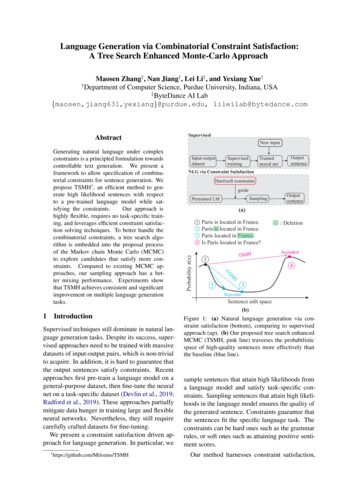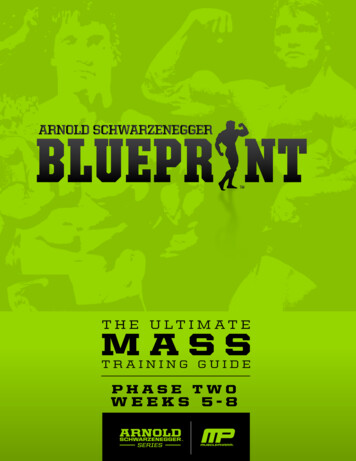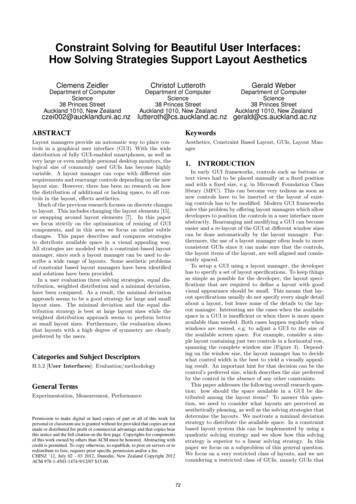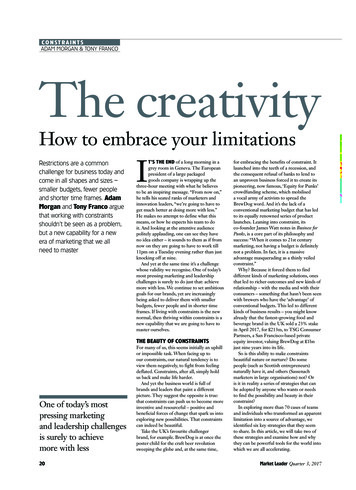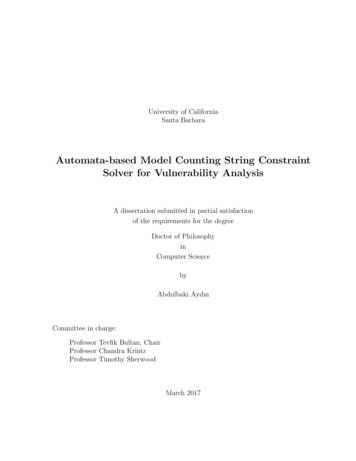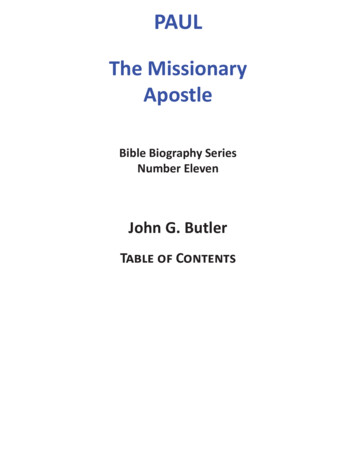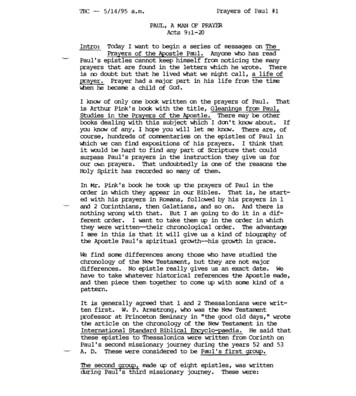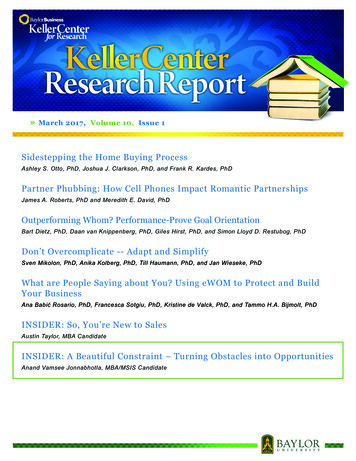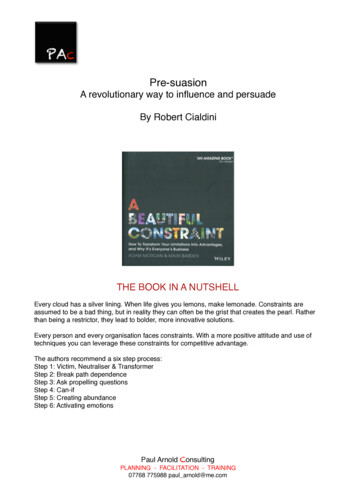
Transcription
Pre-suasionA revolutionary way to influence and persuadeBy Robert CialdiniTHE BOOK IN A NUTSHELLEvery cloud has a silver lining. When life gives you lemons, make lemonade. Constraints areassumed to be a bad thing, but in reality they can often be the grist that creates the pearl. Ratherthan being a restrictor, they lead to bolder, more innovative solutions.Every person and every organisation faces constraints. With a more positive attitude and use oftechniques you can leverage these constraints for competitive advantage.The authors recommend a six step process:Step 1: Victim, Neutraliser & TransformerStep 2: Break path dependenceStep 3: Ask propelling questionsStep 4: Can-ifStep 5: Creating abundanceStep 6: Activating emotionsPaul Arnold ConsultingPLANNING - FACILITATION - TRAINING07768 775988 paul arnold@me.com
THE BOOKIntroductionA constraint is a limitation imposed by outside circumstances or by ourselves that materially affectsour ability to do something. The authors prefer the definition. ‘A limitation or defining parameter,often the stimulus to find a better way of doing something.’We should view constraints not as a restrictor but rather a stimulus for increased creativity andpositive change. Many managerial systems focus on either managing out or removing constraintfrom a system. This book however advocates embracing the constraint.There are three types of constraint:-Foundation - A limit in one of the key success factors of a category - e.g. Zappo’s onlineshoe retailer where customers can’t try on the shoes in store. To overcome this constraint theyoffered free return shipping.- Resource - Raw materials, time, money and people/talent etc - e.g. Southwest airline whohad only three planes but four routes to serve. To overcome this they revolutionised the industry bydeveloping a turnaround time of just 10 minutes when it was one hour.- Method - Where have to do something in a certain way e.g. Aravind eye hospital in Indiaused the principles from fast food to overcome the log jam in eye surgery.The two solid fuel engines that power the space shuttle are 4 feet 8.5 inches wideas that is the width of the railway tracks needed to carry them from Utah to Florida.4 feet 8.5 inches is the size of the roads first built by the Romans. Thus one of themost advanced pieces of technology is constrained by a convention set up 2000years ago.Mick Jagger’s unique dance came about from years of performing on tiny stages insmall clubs.Google’s home page is simple because Larry Page was not adept at coding.Simcha Blass from Netafim (Israel) noticed that one tree had grown taller thanothers planted at the same time. A burst pipe meant water constantly dripped nearthe tree. Tests helped him discover that drip irrigation not only leads to increasedgrowth of crops by 20% but also used 50% less water.Super-Mario characterisation came about due to the poor pixelation on eight-bittechnology.Twitter’s constrained 140 character limit has driven its popularity.Paul Arnold ConsultingPLANNING - FACILITATION - TRAINING07768 775988 paul arnold@me.com
The book suggests a stepwise approach to turn constraint into abundance by a three part, six stepprocess:Part 1 - MindsetStep 1: Victim, Neutraliser & TransformerStep 2: Break path dependencePart 2 - MethodStep 3: Ask propelling questionsStep 4: Can-ifStep 5: Creating abundancePart 3 - MotivationStep 6: Activating emotionsStep 1: Victim, Neutraliser & TransformerHow you perceive a constraint will affect your ability to deal with it.There are three kinds of mindsets that influence how you approach a constraint:-Victim - Sees the constraint as a limiting problem so will lower their ambition.- Neutraliser - Sees the constraint as a roadblock on the way to their ambition. They will finda way around it without compromising their goal.- Transformer - Sees the constraint as an opportunity to improve their goal.Different constraints at different times trigger different reactions. Often people go through all three.In 1980’s Dan Wieden was briefed by Phil Knight at Nike that he do not want anyadvertising that looked, felt or smelt like advertising. Wieden stuck a photo ofFinnish Olympic runner Lasse Viren above his desk and thought what would he sayto him that would not make him laugh? Since then the culture inside the agency isto ‘walk in stupid each day’ (so not driven by past convention).Marissa Mayer (ex Google) knew the importance of self imposed constraints: “Weneed constraints in order to fuel passion and insight”. Her team was restricted insize (625Gb) and teams of just three people with just one day to create aprototype.To help get into the right mainframe, the authors pose a few questions to challenge yourself with.What if you increase the level of the constraint (e.g. from 12 months to 6 months; from 20%increase to 100% increase .). Then answer the following questions:1) Do you believe it is possible? (Mindset)2) Do you know how to do it? (Method)3) How much do you really want it? (Motivation)Paul Arnold ConsultingPLANNING - FACILITATION - TRAINING07768 775988 paul arnold@me.com
As regards mindset, it’s useful to think of past times where you (or others) have beaten the odds.Be aware of your surrounding culture (be it your organisation or personal circles) as these groupscan unconsciously influence you positively or negatively. Are you surrounded by ‘Can-do’ people or‘Can-not’ people?When Yves Behar first presented the idea of providing a laptop per child for 100,he was constantly confronted by nay-sayers.Sir David Ogilvy once said, “Thank goodness of the freedom of a tight brief”. It’s thevery constraint that creates creativity not hampers it.Psychologists found that when a fence was erected in a playground, the childrenused more of the space than before.Jerry Seinfeld imposed self constraint (of no sex or swearing) to raise his owncomic creativity.Step 2: Break path dependenceWe get locked into doing things certain ways without even thinking why. This blocks creativity.Constraint forces us to challenge these.Sydow, Schreyogg and Koch suggested organisations go through three stages of pathdependence:Stage 1: Broad range of approaches used - Left up to managerial discretionStage 2: Adoption of ‘best practice’ - One recommended approach. Some degree offlexibilityStage 3: Locked in - No room for flexibility. Often by this stage it becomes unconscious andnever challenged.Thus we tend to approach problems in the same way. We look at the same data, we ask similarquestions, judge things on the same old criteria, involve similar partners, look at past solutions, andend up making the same decisions. No wonder we rarely unlock those intransigent problems! Evenwith completely new situations we tend to use old patterns (Einstein once said, “We can't solveproblems by using the same kind of thinking we used when we created them” - Ed).Historic reporting structures and language can lock us in (e.g. US government still reportemployment in terms of ‘non-farm payroll’. Also a department called ‘optics’ will assume allanswers must lie in optics). Daniel Kahnemen talks about how the naming of something makes theinvisible become visible.Paul Arnold ConsultingPLANNING - FACILITATION - TRAINING07768 775988 paul arnold@me.com
There are three types of ‘lock in’:- Cognitive - Personal limiting mainframes- Cultural - Collective limiting mind-frames and- ProceduralPeople outside an industry are free of the locked-in mindset. This allows them to see newrevolutionary solutions that the current incumbents are blind to.Moore’s law is as much a mindset as it is about the physics. Because peoplebelieve the story, they make it happen.Reverse innovation - rather than taking a product developed in an advancedmarket, creative innovation can come from working in more naive, developingmarkets who are able to think differently and so open up new possibilities cf thecheap car was developed in India.Dr Louise Waters is the CEO of Leadership Public Schools in San Francisco. Shenoticed that kids from deprived backgrounds were 4-5 years behind in educationstandards by the time they reached high school. Rather than be constrained bythis, she set an ambitious target that all her pupils would reach the standards byhigh school age (yet with no extra funding). This led to different approaches suchas tailored learning for each child, and getting instant feedback on learning via arevolutionary piece of technology.When Nike developed their Flyknit shoes they needed to forget everything theyknew about how to make uppers.Breaking path dependence first requires an awareness of dependence and challenging theaccepted wisdom (e.g. the benchmarks and KPI’s used, the current relationships used etc etc). It’soften achieved over many small steps as opposed to one big jump. The authors suggest identifyingthe most important six words used in an organisation and to then interrogate them. Furthermorethey recommend mapping out all the process steps and challenging each one. It’s also worthwhilelooking at things through a different lens (e.g. using external people - including your consumers).Unilever challenged its own assumptions, by asking what would happen to taste ifthey increased the amount of green tomatoes allowed in their recipes from 5 to10% - a criteria set many years before and had never been challenged.Surf dug deeper into their ‘Savvy shopper’ segment by mapping their entire daythrough the lens of the snakes and ladders game. They identified that cleaning islonely and joyless. This allowed them to build new emotions into the brand.Visa changed who they wanted to be benchmarked against from their standardcompetitors such as Mastercard to the world’s most powerful brands such as Appleand Nike.The US Navy had to break many paths of dependence to develop aircraft carriers.One of the other sources to break conventions is to start asking different questions (ask the samequestions, get the same answers). For example, asking how to market a brand when in heavyPaul Arnold ConsultingPLANNING - FACILITATION - TRAINING07768 775988 paul arnold@me.com
constraint (such as dark markets where no advertising is allowed as small brands are effectively inthe dark shadows of high spending brands).Virgin use the flight safety video as another ‘advertising space’ to demonstrate thebrands distinctive personality.Step 3: Ask propelling questionsPart of the way to break through is to start asking more powerful questions.Just focusing on being ‘a bit better’ than your competition is a recipe for extinction. You need tothink bigger - and focus on better meeting the real needs of your consumers. “Don’t just be ‘better’,be really amazing”, says Larry Page of Google. He sees his role to ask bigger questions. He callsthese ‘10x’ questions. He asks questions that on the surface seem ridiculous or impossible, suchas “How can we reduce car accidents?” Asking impossibly difficult questions demands novelsolutions rather than staying inside the normal parameters of problem solution.These ‘How to’ or ‘How can’ questions are called Propelling Questions as they force you to thinkdifferently. A propelling question has both a bold ambition and a significant constraint.The construct of a propelling questions is asking a How to .(Bold ambition) with (constraint)e.g. How to grow better barley with less water?IKEA asked a propelling question: “How to make a durable, well-designed table for 5?” To answer this, they had to ignore the conventions of table making andexplore lateral solutions. They found the answer by sawing doors in half.Audi asked a propelling question: “How to win LeMans if our car could go no fasterthan the others?” The answer was to make it more fuel efficient (as less pit stops).Hence the development of the first Diesel racing car that won LeMans three yearsin a row.Made.com asked a propelling question: “How to exhibit at the world’s mostprestigious furniture exhibitions in Milan without paying for an exhibition hall?” Theywere able to borrow the apartments of four of their supporters and used them asexhibition spaces. They received over 1,000 guests.SAB asked, “How to increase barley yield and quality while reducing waterconsumption by 10%?” They spoke to Barley farmers and found that barley growthhas three distinct stages. Reduced water in the middle stage promotes growth. Thenew approach reduced water consumption by 48%, yet increased yield (with areduced cost per hectare of 40).George Bernard Shaw once wrote, “The reasonable man adapts himself to the world, while theunreasonable man persists in adapting the world to himself .therefore all progress belongs to theunreasonable man”. Consumers are becoming more demanding - compromise is no longertolerated (which becomes an empowering constraint). Those who unlock an area of compromise ina category open themselves up to great fortunes.Paul Arnold ConsultingPLANNING - FACILITATION - TRAINING07768 775988 paul arnold@me.com
The authors identify a range of different areas of constraint (but there may be others unique to yourorganisation):- Constraint of Foundation - A fundamental foundation for success - e.g. How to see shoeswithout a retail outlet on the high streets?- Constraint of Resource - Budget, time, people, skills, knowledge - e.g. How to launch anew rum brand without a budget?- Constraint of Method - Where constrained by a certain mode of delivery - e.g. How to winat LeMans without a faster car?There are of course many external constraints on an organizations as well (e.g. Political,Economic, Social, Technological, Environmental, Legal, etc)There are four sources of ‘unreasonableness’:- The unreasonable regulator - e.g. US Government set corporate average fuel economygoals of 54.5miles per gallon by 2025.- The unreasonable consumer - Why can’t I have high fashion items at high street prices? Iwant cleaners that clean as well as other products but are ecologically friendly. I want the bestmobile phones and the best networks without being tied into a contract etc.- The unreasonable customer - e.g. Walmart demand higher standards of pricing pointsfrom its suppliers.- The unreasonable challenger - Challengers from outside the category. e.g. Air BnB. Orchallengers from a young upstart in a category - e.g. Tesla vs Mercedes.Step 4: Can-ifOptimism erodes away over time. That’s why we need propelling questions and leaders thatkeeping inspiring action towards the goal. Academics have shown that positivity correlates withboth resilience and openness. You need to keep focus on what has to happen to make it workrather than be de-railed by why it can’t work. The authors coin a phrase, ‘Can If’ (versus, ‘Wecan’t because ’).Fail your way forward - Keep investing in solving the problem. If at first you don’t succeed, find anew way (rather than getting trapped in just trying to do the same strategy again). So don’t fall inlove with your strategy else it will blind you to its failings.IDEO’s Tim Brown has observed that constraints (like most issues) are rarely one-dimensional.Thus to really unpick a problem requires multiple layers of ‘Can If.Taiwan needed to build a robust economic platform to withstand the pressures frommainland China, but they had a key constraint, natural resources. So the propellingquestion became, ‘How do we boost our economy without natural resources? ThePaul Arnold ConsultingPLANNING - FACILITATION - TRAINING07768 775988 paul arnold@me.com
first level answer from their ‘Can If’ questions was, “We can boost our economywithout natural resources IF we increased the level of education”. But this led tothe next constraint of a lack of teachers. Their next ‘Can.If’ helped them to utilisegraduates as teachers. This then fed the next identified constraint of lack ofschools. This resulted in identifying new sources of funds (effectively taking fundsfrom other government departments who would all benefit from raised educationalstandards). Since improving the education, Taiwan's economy has grown by c9%every year for 30 years (higher than Japan). They are a country of just 23m yethave the fourth largest cash reserves in the world.Useful sources of ‘Can If’ are:We can if we think of it as - Metaphorical approaches that breaks the constrained patternof thinking - e.g. Health services who see patients as customers.In the time it takes to load a game, players can now practice their skills - so nolonger see the upload time as a negative experience of the game.We can.if we use other people to - Think laterally about who to ask help from.DuoLingo has 1.2m people translating for free as they see it as an opportunity toimprove their language skills.We can.if we remove x - Often simplifying a process helps unlock value and time.A chain of hair colouring salons in New Zealand stopped drying customers hair,allowing the stylists to move quicker onto new customers, saving time and money.CitizenM looked at what people most wanted in a great hotel experience (bed,shower, technology and design) and took away the things that mattered less (nodouble sinks, no robes, no slippers, no tea, no minibar, no paper receipts etc).Thusthey were able to offer top hotel experience at 75% of the price.We can if we access knowledge of - Finding new sources of knowledge.PHD, the global media agency, tapped into the knowledge resource of its 3,000global employee base. A brief would be open to all employees (it included agaming element where there was a publicised leader board of those who hadcontributed the most).We can if we introduce a - New product or service.Surf increased its fragrance levels leading to a more emotionally rewardingexperience. Surf grew by 36% globally from 2009 to 2012.We can if we substitute x for y - e.g. substituting an airbag ‘scarf’ for a cycle helmet (asmany people found helmets flattened their hair).We can if we fund it by - Finding new sources of funding e.g. crowd sourcing, customersourcing (cf BrewDog) etc.Paul Arnold ConsultingPLANNING - FACILITATION - TRAINING07768 775988 paul arnold@me.com
We can if we mix together - Putting new things together.Recipes generated by a computer led to ‘Thai Swiss Asparagus Quiche’.We can if we resource it by - Finding new resources that currently do not have. E.g.Rent a runway wanted to rent out top designer fashions, but they did not have the finance to buythe items. So they convinced top designers to supply them the dresses for free. Uber, AirBnB andBlaBlaCar riding service in France are all examples of tapping into new sources.In Kenya, chicken farmers were losing a lot of chicks to arial predators such aseagles and hawks. The other issue was disease. But farmers did not want toinvest in inoculating all their chicks since most of them got eaten. By painting thechicks blue the eagles did not recognise them, thus increasing the yield, making itmore cost effective for farmers to inoculate. These two measures increasedsurvival rates from 20% to c85%. However, this created a knock-on problem: food.The Can if solution was to exploit the underground legions of termites. But thenext issue was how to ‘excavate’ them? Another part of Kenya had already solvedthis issue using bundles of waste crop soaked in water.Step 5: Creating abundancePaul Arnold ConsultingPLANNING - FACILITATION - TRAINING07768 775988 paul arnold@me.com
The award winning TV show, ‘Whose line is it anyway’ works off the core idea of constrainedresources. The comedians see this as a leverage point for creativity rather than a restriction. It’seasy solving problems with more resources - but more fun and rewarding to do it with less. To startyou need a positive mindset. Secondly we need to be open to new sources. People born intopoverty tend to be more resourceful than those born into a world of abundance. Thirdly, we rarelymine all the resource opportunities we have around us as. For example we only think of resourcesas those being within our immediate control; we tend to wait for resources to be given to us ratherthan going out hunting for new ones; the resources we do have we do not extract all the resourcespossible from them. Finally we do not think what resources we have that we could barter with.There are four common resources to explore:- Invested stakeholders - e.g. made.com were able to exhibit at Milan by displaying theirfurniture in four of their customers spaces- External partners - e.g SAB working closely with farmers- Resource owners - e.g. The NGO Colalife used CocaCola’s distribution might to deliverpacks of their dehydration salts to children suffering from diarrhoea across Africa- Competition - e.g. Ford & Toyota collaborating on technologies for hybrid trucks.When Virgin America launched in 2007 their goal was to ‘put glamour back into airtravel’. They wanted their airlines to feel like nightclubs in the sky. But they lackedmoney for the launch. They saw the planes as an asset they could leverage. Sothey flew Victoria Secret’s models to their annual fashion show (gaining lots of PRfor their in flight pyjama party).This who share our agenda/values/mission/purpose are more likely to contribute resources. Alsothose who recognise they lack something we have will also be up for bartering. The aim should beto work on selling people our mission/purpose/values etc and also helping them to see that whatwe have is what they re missing.The World Association of Girl Guides and Girl Scouts benefits from the Dove SelfEsteem program as they have a shared vision of preparing girls to become fullyfunctioning successful adults.Nike gave away the intellectual property rights for its ‘Making’ app (which catalogs75,000 different materials by environmental impact and sustainability) becauseNike values a sustainable future for all.Paul Arnold ConsultingPLANNING - FACILITATION - TRAINING07768 775988 paul arnold@me.com
Step 6: Activating emotionsAdmiral William McRaven, Commander of the US Special Operations Command wrote a bookcalled Spec Ops. In it he discussed six principles that make special operations successful Simplicity, Security, Repetition, Surprise, Speed and Purpose. Purpose helps drive meaning andinternal motivation that overcomes the barriers along the way. It turns something from a want to aMUST.Gallup has shown how giving people meaning at work drives performance (after all if you don’tcare about the problem then less likely to solve it). Angela Duckworth identified ‘grit’ as a keycomponent of successful people - that tenacity to keep on pushing forward towards a goal despiteobstacles, hurdles and failure. She found out it was a bigger predictor of success than IQ.‘Desirable Difficulties’ describes the notion that there can be some advantages of a disadvantage.For example, a person from a ‘constrained’ background may be more resilient, more resourcefuland may have more drive to succeed than those born into affluence.No way out - When you offer people an ‘early exit’ strategy it allows people to opt out, and not keeppushing. If there is no way out of something, then people are forced to keep on pushing.Utilising different emotions - Negative emotions can be a powerful driver leading to persistence,commitment and focus. Dan Wieden (W&K advertising) likes a milder form of fear - anxiety. “If youcan remain insecure, yet optimistic, you’ve got a pretty good chance of changing the world”. Manybrands are born from dissatisfaction with the category. BrewDog came about because its founderhated the ‘mainstream, industrial, monolithic, insipid, bland, tasteless, apathetic beers thatdominate the market’, making them into the ‘punks’ of beer.The UK pub chain, JD Wetherspoon was named after a teacher who told TimMartin he would never amount to anything.Juxtaposing an ‘away from’ negative emotion with a ‘towards’ positive emotion offers an evengreater chance of success. Research has shown that the most successful problem solvers togglebetween looking at a broad range of stimuli (which relies on positive emotional energy) and thenswitching o a focused persistence (ideally driven by fear and anger as these help you really focusyour energies). Jack Dorsey, the founder of Twitter and Square talked about this value of tension insetting up his businesses.Paul Arnold ConsultingPLANNING - FACILITATION - TRAINING07768 775988 paul arnold@me.com
Prof. Gabriele Oettingen, the head of Motivation at New York University has distinguished threeapproaches to reach a desired outcome:- Indulging - Create a vivid picture of what it would look like if (so inspired by its positiveemotions).- Dwelling - Sitting in a place of negativity where think of all the things that could go wrongor what would happen if did not achieve this goal. This creates the anxiety and fear that motivates.- Toggling - The most effective space. It’s a bit like an electric motor - the shifting between ve and ve creates the drive.Critically though, it does need a plan that gets actioned!Stanford’s Design for Extreme Affordability is one of the most difficult courses toget into (only 6% applications accepted). They look for EQ (emotional intelligence)as much as IQ as they realise the inter-relationships between the students iscritical to problem solving. They deal with high stress situations (e.g. prematurebabies) so they need to remain calm under pressure.The fertile zeroThe resource curse - Countries rich in natural resources tend to do worse economically than thosewithout resources (Norway accepted) as excess resources leads to complacency. This theme runstrue with organisations and individuals.Tobacco companies bankrolled Formula one for decades. In 2005 the gravy trainended with the banning of tobacco sponsorship. Ron Dennis, the leader ofMcLaren instructed that every single process be interrogated to identify areas ofsavings and improvement. This led to many step change processes, one of whichincluded reducing pit stops from 4sec to 2.5sec.Sometimes going for ‘zero’ can unlock new creative solutions. Some routes to explore are:- Drama & surprise - BrewDog had no money and hence no advertising (in a categorywhere advertising drives sales). This forced them to be creative and make the brand come alive insocial media. Drama helps the brand stand out, create attention and engages emotions. It alsopromotes conversation and creates memorability. It’s recommended to be ‘unexpected’ to createsurprise.Warby Parker, the eye wear specialists created an unexpected annual report wherethey talked about the inner workings (including unexpected facts and mistakes).Prof Sir Andre Geim found it difficult to convince his science peers aboutelectromagnetism - so he levitated a frog to bring alive the power ofelectormagnatism.Paul Arnold ConsultingPLANNING - FACILITATION - TRAINING07768 775988 paul arnold@me.com
- Being interesting on the inside - If you do not have the budget to talk about yourself, youneed to get others to talk about you. To do this you need a great story. If it’s not interesting, it’s notshared. Thus the focus is on creating interest.Sailor Jerry Rum was created by an advertising creative called Steve Grasse fromhis agency Quaker Mercantile. Ironically he built it with no advertising spend. Thebrand was built through support of grass roots movement amongst punk bandsand a clothing range (Grasse talks about how it is key to be true to the tribe youwant to engage). He claims that because he did not know how rum brands weremeant to ‘behave’ he did it his own way, defying the conventions of the category.Grasse’s next project was recreating old pre-industrial folk recipes such asRhubarb tea (The story behind this is Benjamin Franklin brought rhubarb seeds toAmerica and gave it to the King’s Botanist, John Bertram who developed a tea fromit).Cordarounds sell corduroy trousers with their ridges running horizontally ratherthan vertically. They are distinctive and it creates a talking point.Aesop beauty brand has grown to 43 stores worldwide.They want to putintelligence into beauty. Thus their shop staff were asked to refrain from mindlesssmall talk/chatter.- Making a secondary medium your primary idea platform - This is about owning adistinctive media space.Alcohol advertising was banned in the 80’s in France. Heineken developeddifferent bottle shapes and sizes to match different drinking occasions, helping itgrow by 600%.- Alliance to scale - Building new types of partnership. History has shown great advancesare made when there is a strong coalition of people working towards a common goalCitizenM did not have money for mass refurbishment. Vita, the Swiss furniturecompany also did not have the money co-develop retail outlets. A coalition meantCitizen M got their lobbies decorated for free, and Vitra got a showroom in everycity.- Other people’s resources - Using customers and consumers as your R&D resource.- Commercial innovation Vitamin water developed an alliance with the rapper 50 Cent.English Rugby needed to raise 2.5m in 2011. They placed a 250,000 bet with thebookies that they would win.Constraint driven culturesPaul Arnold ConsultingPLANNING - FACILITATION - TRAINING07768 775988 paul arnold@me.com
The culture of an organisation influences the accepted behaviour. Often the history (the ways thecompany does things) and the values of the founder/senior leaders can deeply affect currentbehaviour. Embracing constraints is part and parcel of some organisation’s culture. The keysuccess factors appear to be:-Big ambition and strong intent-Start from the top and empower key people-Make it central to the business-Be consistent-Be willing to challenge and interrogate every partnership and process-Be a storytelling cultureIngvar Kamprad, the founder of IKEA came from Smaland, a place that used therocks from the fields to build the walls and the road. Kamprad was always lookingat ways of reducing/using waste (hence why he used the feathers from pluckedchickens to make affordable duvets). Such attitudes run all the way thro
positive change. Many managerial systems focus on either managing out or removing constraint from a system. This book however advocates embracing the constraint. There are three types of constraint:-Foundation - A limit in one of the key success factors of a category - e.g. Zappo's online
